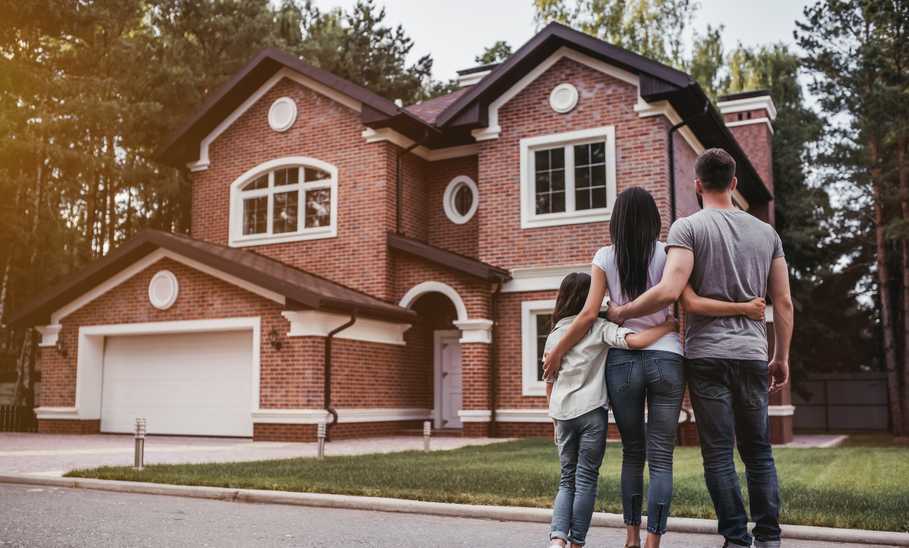- Very common, offered by most lenders.
- Down payment requirements as low as 3%.
- Options and requirements can be more flexible than other loan types.
Conventional Loan: What You Need to Know to Qualify

Our evaluations and opinions are not influenced by our advertising relationships, but we may earn a commission from our partners’ links. This content is created by TIME Stamped, under TIME’s direction and produced in accordance with TIME’s editorial guidelines and overseen by TIME’s editorial staff. Learn more about it.
When you think of a typical mortgage loan, you probably envision a conventional loan. Conventional loans are the most common type of mortgage loan today. They allow homebuyers to finance the purchase of a primary, vacation, or investment home with repayment terms of up to 30 years (or sometimes more).
Conventional loans can be more flexible and, in many cases, more competitive than other types of home mortgage loans. Because of this, though, it can also be more difficult to qualify for one. Here’s a look at what a conventional mortgage loan is and what you need to know in order to qualify for one.
A conventional mortgage loan is any standard home loan that isn’t insured or backed by a specific government program, such as a USDA loan, VA loan, or FHA loan. Conventional loans are available to everyday borrowers who don’t need to qualify for these government programs, though the loans may have stricter eligibility requirements.
Nearly every lender offers conventional loans, including banks and credit unions. Conventional mortgages are also the most common type of home loan and can be used to purchase primary homes, second homes, and investment properties.
With a conventional mortgage loan, you will receive your loan funds upfront in order to make the purchase of your home. Depending on your qualifications, this might be as much as 97% of your new home’s purchase price, minus any down payment requirement.
Once you’re approved, the funds will be sent to your seller at closing in order to complete the transaction, after you’ve covered your down payment and closing costs. You’ll then repay your loan monthly according to your lender’s loan agreement, for the duration of your loan term or until you sell the property and pay off the loan with the proceeds.
Your monthly payment includes both principal and interest (P&I) toward your loan. If you choose to escrow your homeowners insurance and property taxes, these will also be part of your monthly loan payment. When all four expenses are added together, they are referred to as PITI.
You may also be responsible for paying private mortgage insurance (PMI), if you don’t put 20% down on your new home. PMI helps protect your lender in case you default on your loan. It is usually required on conventional loans until you reach 20% equity in your property or make at least half of your scheduled payments.
There are two primary types of conventional home mortgage loans to choose from: conforming and non-conforming. The right one for you depends on the property you’re purchasing, your personal preferences, the lender you choose, and your eligibility.
Here’s a rundown of conforming versus non-conforming mortgage loans, what each one offers, and how to choose a mortgage lender and loan type.
Conforming mortgage loans are those that are backed by government sponsored enterprises (GSEs) like Fannie Mae and Freddie Mac. These mortgages have maximum loan limits that are set by the government, based on location and cost of living calculations. Conventional conforming home loans can be fixed-rate mortgages, adjustable rate mortgages (ARMs), or jumbo loans.
For 2024, the conforming loan limit on a single-unit property is $766,550. Depending on where you live, though, and the number of units in the property you’re buying, the limit may be higher or lower.
Loans that cannot be backed or repurchased by Fannie Mae or Freddie Mac fall into the category of non-conforming loans. These loans don’t meet the Federal Housing Administration’s (FHA) conforming loan limit requirements so they aren’t guaranteed by these GSEs. Because of this, they often represent a greater risk to mortgage lenders and may come with higher interest rates and/or less competitive loan terms.
As with conforming loans, non-conforming mortgages can come in different varieties, including jumbo loans, fixed-rate loans, and ARMs.
If you’ve decided that a conventional mortgage is right for you, here are the steps you’ll need to take to apply and get approved.
How much can you afford to put down on your home purchase? The answer to this question will not only help you choose the right mortgage loan, but will also allow you to select your house budget and determine your estimated monthly payment amount. While 20% down is an ideal amount, conventional lenders will often accept a down payment as low as 3% if you qualify.
Even if you don’t have a specific house in mind yet, setting a budget allows you to determine how much you will likely need to borrow. You can then use this information to shop around for lenders, estimate your monthly payment, and even get pre-approved for a loan so you can begin submitting offers.
Many mortgage lenders offer loan pre-approval, which is a conditional loan approval—up to a certain dollar amount. The amount is based on limited eligibility factors such as your income and a soft credit check. With a pre-approval letter, you are often viewed as a more competitive buyer. This may even be a requirement before you’re allowed to view certain homes.
Loan pre-approval is not the same as approval, however. Once underwriting begins, the lender can still decide that you don’t qualify based on things like your financial and credit situation, so take this with a grain of salt.
You can also begin considering potential repayment options to determine which loan terms work best for your budget. This means deciding between repayment terms that might range from 10 to 30 years in length, and even altering your down payment amount to adjust your monthly payment moving forward. Keep in mind that there may be stricter eligibility requirements for longer loan terms or smaller down payments.
If you haven’t already, you can begin shopping around for your perfect home to purchase. If you’ve been pre-approved, you can use this letter to begin touring properties and even submit offers for homes that fit your criteria and meet the lender’s pre-approved loan limits.
Once you’re locked in with an accepted offer, it’s time to move forward with the actual loan approval process. Your lender will assign you a loan officer, who will begin underwriting your loan to determine whether or not you actually qualify. This process will continue up until your closing date, when your lender will pull your credit one last time to make sure nothing has changed.
Expect to provide your lender with a lot of personal and financial information throughout the underwriting process. This typically includes things like bank statements, tax returns, and pay stubs. If you’re self-employed or have alternative income sources, you’ll need to provide additional information, such as receipts, profit and loss statements, and more tax returns.
Once your loan is approved and all other boxes have been checked in the closing process—like receiving a completed home inspection report, an appraisal report, and an official title search—you can close on the property. On the day of closing, you’ll be responsible for sending the seller your portion of the purchase price including your down payment, closing costs, and other fees. Your mortgage lender will send the remaining balance directly to the seller or the seller’s lienholder.
Each mortgage lender sets its own eligibility requirements, which may vary from one type of loan to the next and can even be based on location. It’s always smart to shop around with multiple lenders not only to see where you best qualify, but also to find out which lender will offer you the lowest possible interest rate for your specific purchase and situation.
On average, conventional mortgage lenders will require you to have a credit score of at least 620 in order to qualify for a home loan. Some may require a higher score, starting at 640 or 660. This requirement can change depending on the loan terms you choose. If you want a 30-year mortgage, for example, you may need a higher score than if you want a 10- or 15-year loan. In general, the higher your credit score, the more options you have for favorable interest rate and loan terms.
Lenders want to know that you’ll be able repay your debt, especially for a home that will take you several decades to pay off. This means looking at your current income and household expenses to see if you make enough to cover the loan payments.
It’s not just about your income. Your lender will also look at how much you make compared to your existing debt obligations. Existing debts have monthly payment requirements, which will already account for some of your income, leaving you less to put toward your new debts (like a mortgage payment).
This calculation is called your debt-to-income ratio, or DTI. Each lender has its own DTI threshold, but typically they won’t want you to exceed about 43%.
In order to qualify for a loan, you’ll need to have a sufficient down payment saved. Conventional loans allow for down payments as low as 3%, though you may be expected to put down more depending on your location, purchase price, loan term, or even your credit score. To avoid having to pay for PMI, plan to put down at least 20%, or enough to have at least 20% equity in your new home.
Each lender will set its own limits regarding loan amounts, which may also be based on the types of conventional loans offered. If you’re trying to buy a home, your borrowed amount will need to fall within the lender’s loan range limits in order for you to qualify. Need to borrow more (or less)? You’ll need to shop around for a different lender.
Not sure if a conventional home mortgage loan is right for you? Here’s how they compare to other common loan types.
Home loans insured by the Federal Housing Administration are called FHA loans. These loans, which are also offered by FHA-approved private lenders, have much lower credit score requirements than conventional loans, though down payment requirements are similar (as low as 3.5%). For some borrowers—especially those with lower credit scores—FHA loans can be more affordable than conventional loans.
VA loans are home loans insured by the Department of Veterans Affairs. These loans are offered by approved private lenders and are available to eligible military service members, veterans, and certain surviving spouses. Down payments can be as low as 0% and closing costs are also limited, though interest rates may be higher than conventional loans for some borrowers. VA loans are also subject to loan limits.
Home mortgages through the Rural Housing Service program are called United States Department of Agriculture (USDA) loans. They offer loans to qualified rural residents with low or moderate incomes who may not qualify for a conventional loan. These loans can have even lower credit score and down payment requirements than the best online mortgage lenders (as low as 0% down) but may be subject to stricter criteria regarding location and loan amount.
If you don’t qualify for a conventional mortgage loan or think it might not be the ideal choice for you, here are some alternatives to consider:
A conventional mortgage is the most popular home loan today. With widespread availability and no shortage of flexibility, these loans make it easier for borrowers to buy the home they want with terms they can afford. However, conventional loans may have higher credit score requirements, making approval more difficult for some borrowers. Buyers are also subject to various closing costs and even private mortgage insurance, depending on their down payment, sometimes making them more costly.
Conventional loans have many benefits, including widespread availability, competitive interest rates, flexible loan terms, and down payments as low as 3% in many cases.
The disadvantages of conventional mortgage loans include higher credit score requirements, fluctuating closing costs, the potential for private mortgage insurance, and borrowing limits (depending on whether the loan is conforming or non-conforming).
In general, the minimum you can put down on a conventional loan is 3% of the purchase price. However, some lenders may set higher minimums of 5% or more depending on loan term, borrowed amount, location, your credit score, and your debt-to-income ratio.
While it depends on your mortgage lender’s requirements and factors such as your existing debts and obligations, you generally shouldn’t plan to spend more than 25% of your net monthly income on your mortgage payment.
Yes. A conventional loan can be, and often is, used to purchase investment property. These loans can be more flexible and offer more competitive terms than other loan types. They also allow for secondary and vacation property purchases. This is not the case with certain government-insured mortgages, which are only available to finance your primary residence.
The information presented here is created by TIME Stamped and overseen by TIME editorial staff. To learn more, see our About Us page.



